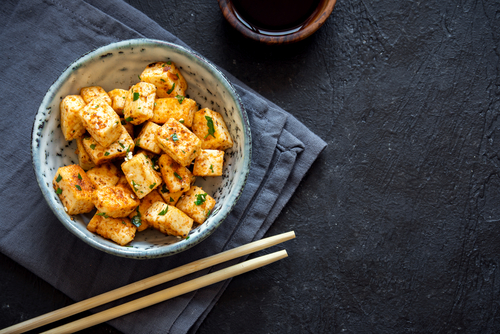Tofu 101: The Health Benefits of Tofu - and How to Cook It
Living in today’s plant-based world, it is not surprising to discover tofu in every grocery store in North America. But what you might find surprising is that tofu has been around for centuries! Apparently, the first written record of tofu dates back to 950 A.D. For such a humble, versatile, ancient food why is it still such a mystery? According to the Economist and Forbes magazine, 2019 is the year of the vegan, so it is about time we dig deep into tofu and explore exactly what it is, how it is made and whether it is healthy or not.
What is Tofu?
Tofu is processed soybean curd. If that sounds weird, it’s not that different than cheese…let me explain! The three ingredients behind tofu are soybeans, water and a coagulant—usually nigari (magnesium chloride) or gypsum (calcium sulfate). For all the science geeks out there, a coagulant is a substance that allows fluid to curdle to become a solid. The whole process of making tofu is very similar to cheese making; if you’ve ever made ricotta at home, you know that you add a coagulant (lemon juice) to milk and then separate the casein curds from the liquid whey.
After soaking raw, dried soybeans overnight and then blending those soybeans to make soymilk, the coagulant is added. From there, the soymilk forms curds, which are drained and pressed into blocks to create tofu! That tofu can be further pressed to remove moisture, creating medium, firm or extra firm textures.
Is Soy Safe?
Now that you know what tofu is and how it is made, the next question is, is it healthy?
A few years ago, early animal studies created some bad publicity for soy foods by claiming the estrogen-like compounds found in soy may raise the risk of hormone related cancers. Other rumors declared that men who ate soy foods would develop boobs. Yes, I said it – man boobs!
After the dust settled, what we know now from stronger human studies and a consistent body of research is that soy foods are safe for those diagnosed with cancer AND those without and it will NOT cause man boobs. The fact is that soy foods contain several key nutrients and phytochemicals, including isoflavones. Isoflavones are a group of phytoestrogens, studied for their cancer prevention properties when eaten in similar amounts to a typical Asian diet, which is about two servings a day. It is important to note that phytoestrogens are not the same strength as your body’s own estrogen – in fact, they are known as ‘weak estrogens’ which tend to have a moderating (not strictly additive) effect on your body’s hormone levels.
However, it should be noted that soy supplements may contain a concentrated source of plant estrogens than found in natural whole foods and until more information is available women are being advised to avoid soy supplements (eg. soy products in concentrated or pill form).
The Health Benefits of Tofu
Tofu contains several anti-inflammatory, antioxidant phyto-chemicals making it a great addition to an anti-inflammatory diet. Tofu is also a good source of ‘complete’ protein – meaning that it has a well balanced amino acid profile – in addition to fiber, potassium, magnesium, iron, copper and manganese. Talk about an all-in-one food!
If made with calcium sulfate, tofu also contains high amounts of calcium, so make sure to check the nutrition facts label on the package. Calcium is an important nutrient to pay attention to, especially before you hit 30, as our bones reach their maximum strength and density between the age of 25-30. Don’t get me wrong; it is still important to consume calcium after the age of 30 as we can still replace the bone mass that is lost each day.
If it fits the budget, we recommend purchasing organic tofu to help you minimize your exposure to genetically modified soybeans and hexane used in the production of conventional soy beans.
How to Cook Tofu
Now that you know how healthy tofu can be, need some inspiration on how to prepare it? Here are some tips and recipes to have you using tofu like a pro in no time!
Simmer cubes of medium-firm tofu along with your favorite soup vegetables such as carrots, celery, zucchini, and onions in a broth made of miso dissolved in hot water to create homemade miso soup
Next time you make your usual smoothie add 1/2 cup soft silken tofu instead of your go-to protein powder.
Use sliced smoked tofu (no cooking necessary!) or pan-fried tempeh in a sandwich. One of my favorite sandwiches is a vegan “reuben,” which includes two pieces of cooked tempeh, and sauerkraut all between two slices of rye bread.
Marinate tofu by first cutting it into cubes and tossing it in a tandoori paste mixture (5 Tbsp of tandoori paste with 1 Tbsp of oil). Let marinate for 3-4 hours then pan fry the tofu until all sides are browned. Add to any salad or dish.
And here’s a round up of some of my favorite tofu recipes:
Quick note on storing tofu: if you do not use it all in one go, cover the leftover tofu with cold water in an airtight container and change the water daily. Tofu will keep in the refrigerator for a few days, or you can also freeze firm tofu for up to three months. However, soft or silken tofu should not be frozen.
Now, get cooking!
If you enjoyed this post please click like, share it with family & friends or sign up to our newsletter to receive news and updates from Food Yourself.
Article written for Desiree Nielsen
Wu AH, Lee E, Vigen C. Soy isoflavones and breast cancer. Am Soc Clin Oncol Educ Book. 2013;102-106.
Nechuta SJ, Caan BJ, Chen WY, et al. Soy food intake after diagnosis of breast cancer and survival: an in-depth analysis of combined evidence from cohort studies of US and Chinese women. Am J Clin Nutr. 2012;96(1):123-132.
American Institute for Cancer Research: Soy www.airc.org
A Nutrition Guide for Women with Breast Cancer BC Cancer Agency. 2012


